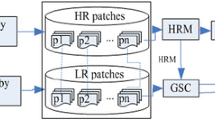Abstract
Monitoring cameras are now widely used to monitor everything from a room in a house to an entire warehouse. However, in real monitoring scenarios, a variety of factors, such as underexposure, optical blurring, defocusing, have an impact on the quality of images, which leads to low-quality and low-resolution (LR) of the individual of interest. Reconstruction of a high-resolution (HR) face image with detailed facial features, from a LR observation based on a set of HR and LR training image pairs, plays an important role in computer vision and face image analysis applications. To super-resolve an HR face given a LR face image, the key issue is how to effectively encode the LR image patch. However, due to stability and accuracy issues, the coding approaches proposed so far are far from satisfactory. In this paper, we present a novel sparse coding method via exploiting the support information on the coding coefficients. According to the distances between the input patch and bases in the dictionary, we first assign different weights to the coding coefficients and then obtain the coding coefficients by solving a weighted sparse problem. Experiments on commonly used databases and some face images on the real monitoring conditions demonstrate that our method outperforms state-of-the-art.








Similar content being viewed by others
References
Baker, S., & Kanad, T. (2000). Hallucinating faces. FG, 83–88.
Liu, C., Shum, H., & Freeman, W. (2007). Face hallucination: theory and practice. International Journal of Computer Vision, 7(1), 115–134.
Wang, X., & Tang, X. (2005). Hallucinating face by eigen-transformation. IEEE Transactions on Systems, Man, and Cybernetics Part C, 35(3), 425–434.
Chang, H., Yeung, D., & Xiong, Y. (2004). Super-resolution through neighbor embedding. CVPR, 275–282.
Yang, J., Tang, H., Ma, Y., & Huang, T. (2008). Face hallucination via sparse coding. ICIP, 1264–1267.
Ma, X., Zhang, J., & Qi, C. (2009). Position-based face hallucination method. ICME, 290–293.
Ma, X., Zhang, J., & Qi, C. (2010). Hallucinating face by position-patch. Pattern Recognition, 43(6), 3178–3194.
Jung, C., Jiao, L., Liu, B., & Gong, M. (2011). Position-patch based face hallucination using convex optimization. IEEE Signal Processing Letters, 18(6), 367–370.
Huang, H., He, H., Fan, X., & Zhang, J. (2010). Super-resolution of human face image using canonical correlation analysis. Pattern Recognition, 43(7), 2532–2543.
Roweis, S. T., & Saul, L. K. (2000). Nonlinear dimensionality reduction by locally linear embedding. Science, 290(5500), 2323–2326.
Yu, K., Zhang, T., & Gong, Y. (2009). Nonlinear learning using local coordinate coding. In Proc. of Advances in Neural Information Processing Systems, pp. 2223–2231.
von Borries, R., Miosso, C. J., & Potes, C. (2007). Compressed sensing using prior information. CAMPSAP, 121–124.
Friedlander, M. P., Mansour, H., Saab, R., & Yılmaz, O. (2012). Re-covering compressively sampled signals using partial support information. IEEE Transactions on Information Theory, 58(2), 1122–1134.
Candes, E., & Rombergt, J. (2005). ℓ1-magic: recovery of sparse signals via convex programming [online]. Available: http://www.acm.caltech.edu/l1magic/.
Kim, S. J., Koh, K., Lustig, M., Boyd, S., & Gorinevsky, D. (2007). A interior-point method for large-scale ℓ1-regularized least squares. IEEE Journal on Selected Topics in Signal Processing, 1(4), 606–617.
Gao, W., Cao, B., Shan, S. G., Chen, X. L., Zhou, D. L., Zhang, X. H., et al. (2008). The CAS-PEAL large-scale Chinese face database and baseline evaluations. IEEE Transactions on Systems, Man, and Cybernetics Part A, 38(1), 149–161.
Wang, Z., Bovik, A., Sheikh, H., & Simoncelli, E. (2004). Image quality assessment: from error visibility to structural similarity. IEEE Transactions on Image Processing, 13(4), 600–612.
Acknowledgments
The research was supported by the major national science and technology special projects (2010ZX03004-003-03, 2010ZX03004-001-03), the National Basic Research Program of China (973 Program) (2009CB320906), the National Natural Science Foundation of China (61231015, 61172173, 61070080, 61003184, 61170023). The research in this paper uses the CAS-PEAL-R1 face database collected under the sponsor of the Chinese National Hi-ech Program and ISVISION Tech. Co. Ltd.
Author information
Authors and Affiliations
Corresponding author
Rights and permissions
About this article
Cite this article
Jiang, J., Hu, R., Han, Z. et al. Low-Resolution and Low-Quality Face Super-Resolution in Monitoring Scene via Support-Driven Sparse Coding. J Sign Process Syst 75, 245–256 (2014). https://doi.org/10.1007/s11265-013-0804-9
Received:
Revised:
Accepted:
Published:
Issue Date:
DOI: https://doi.org/10.1007/s11265-013-0804-9




